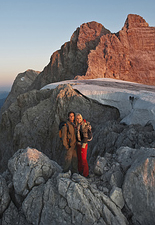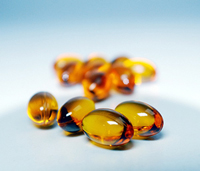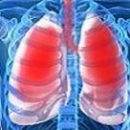Mountains are beautiful, mountain air - he has health, but there are also danger here. Many people, being in the mountains, face acute mountainous disease. The heavy form of this disease is the height swelling of the lungs, about him and let's talk in our article.
Content
 Many of us, being in the mountains, to some extent feel the manifestations of acute mountainous disease - «Pitches» On the vocabulary of the Gorogovatteners. For some «High-rise ceiling» May be very low - signs of mountain sickness appear already at an altitude of 2000-2500 m. Others feel quite comfortable even with a rapid up to 3000-3500 m. Why depends on the development of acute mountainous disease and its degree of severity, as well as the presence of such serious states as high-altitude edema of the brain and lungs?
Many of us, being in the mountains, to some extent feel the manifestations of acute mountainous disease - «Pitches» On the vocabulary of the Gorogovatteners. For some «High-rise ceiling» May be very low - signs of mountain sickness appear already at an altitude of 2000-2500 m. Others feel quite comfortable even with a rapid up to 3000-3500 m. Why depends on the development of acute mountainous disease and its degree of severity, as well as the presence of such serious states as high-altitude edema of the brain and lungs?According to the currently adopted definition of the International Mountain Medicine Society, under acute mountain disease, they understand the painful state arising from the rise above 2500 m above sea level. The main feature is a headache, accompanied by one or more symptoms: disorder of the gastrointestinal tract (decrease in appetite, nausea, vomiting), dizziness, sleep impairment (insomnia, intermittent restless sleep), increased fatigue and weakness. As can be seen, all signs of mountain sickness are very subjective, which sometimes makes it difficult to recognize this state and differentiate it with other diseases that may occur or sharpen in the mountains. In cases where the above signs appeared after 3 days of stay at an altitude of 2500 m and there is no headache, and the state with a decrease in height does not improve, then, most likely, we are talking about another age - the disease of the nervous system, infection, intoxication, etc.
It is proven that the fact that acute mountain disease is more often developing in people with overweight. Increased exercise, chronic infectious process, supercooling, lack of training also contribute to a faster development of mining diseases.
The first harbingers and symptoms of mountain sickness appear when, in the conditions of oxygen deficiency of the body, its organs and systems have not yet managed or no longer able to maintain the normal supply of oxygen tissues. In response to hypoxia, which occurs when inhalation of air with reduced partial pressure of oxygen, in the smallest vessels (capillaries) of the lungs increases blood pressure, which contributes to the exit of the blood components and the development of edema in the lung tissue. Lungs swelling syndrome, representing the final stage of the development of mountainous disease, is a life-degrading state requiring immediate descent of the victim down and drug intervention.
The only method of combating lung edema syndrome is the immediate descent and inhalation of oxygen. Descent even a few hundred meters can lead to improved state. The victim must be given a half-time position (if it did not accept it independently), under the tongue to put a nitroglycerin tablet, and on the hips to impose venous harnesses so that the fabrication of the arteries fare. This will create a blood depot in the lower extremities and will prevent its return to the heart.
Re-nitroglycerin can be given after 20 minutes no more than 3 times. Intramuscularly need to enter 2-3 furosemide ampoules. No medication manipulations should not be a delay to descend down! Elevation of the lungs can very quickly develop against the background of inflammatory diseases of the respiratory tract (angina, pneumonia), so when their signs of person appear, it is necessary to lower down, while at the same time providing symptomatic medication.
 Speaking of prevention, it is impossible not to say about vitamins. One of the most important is ascorbic acid (vitamin C), which has antioxidant properties, t. E. Reducing the accumulation of non-surfacing metabolic products that appear in hypoxia. The daily need for its normal conditions is 70-100 mg, and in acclimatization it is advisable to increase the dose several times. In addition to ascorbic acid, tocopherol (vitamin E) and lipoic acid have antioxidant properties. The study has proven the effectiveness of the prophylactic taking of these drugs according to the following scheme: vitamin C (500 mg), vitamin E (200 mg) and lipoic acid (300 mg) were given twice a day 3 weeks before lifting in the highlands and within 10 days Stay at the height. Participants who took this combination were less suffering from the manifestations of mining diseases, and they have improved their learning.
Speaking of prevention, it is impossible not to say about vitamins. One of the most important is ascorbic acid (vitamin C), which has antioxidant properties, t. E. Reducing the accumulation of non-surfacing metabolic products that appear in hypoxia. The daily need for its normal conditions is 70-100 mg, and in acclimatization it is advisable to increase the dose several times. In addition to ascorbic acid, tocopherol (vitamin E) and lipoic acid have antioxidant properties. The study has proven the effectiveness of the prophylactic taking of these drugs according to the following scheme: vitamin C (500 mg), vitamin E (200 mg) and lipoic acid (300 mg) were given twice a day 3 weeks before lifting in the highlands and within 10 days Stay at the height. Participants who took this combination were less suffering from the manifestations of mining diseases, and they have improved their learning.
It is impossible not to mention and that means that «We had with you» and which experienced and not very robust can often use to combat «Pitry». Austrian scientists specially conducted research: if the use of low doses of alcohol affects (corresponding to 1 l beer) for mining diseases. It was revealed that at an altitude of more than 3000 m, even in small doses, alcohol reduces the frequency of respiration and as a result - blood saturation with oxygen. Therefore, the use of alcoholic beverages in the alpine zone should be prohibited!









